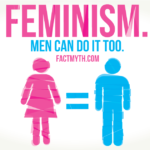Feminism – Mrs Price
Mainstream reference sources agree feminism is about ‘women’s rights’. The Oxford Dictionary defines it as ‘the advocacy of women’s rights on the ground of the equality of the sexes’. The New World Encyclopaedia says that is ‘comprises a number of social, cultural and political movements… concerned with gender inequalities and equal rights for women.’
Attitudes to feminism tend to vary depending on what ‘feminism’ is taken to mean. When people use the word ‘feminism’, they may be talking about any or all of the following:
1. Feminism as an idea: as Marie Shear once put it,
‘the radical notion that women are people’.
2. Feminism as a collective political project: in the words of bell hooks, ‘a movement to end sexism’ sexist exploitation and oppression’.
3. Feminism as an intellectual framework: what the philosopher Nancy Hartsock described as ‘a mode of analysis… a way of asking questions and searching for answers’. (this one is my personal favourite!)
These different meaning for feminism have different histories, and the way they fit together is complicated. The roots of feminism, like those of other modernist theories, can be traced back to the 18th century Enlightenment. These proclaimed universal principles of liberty and equality, along with the idea that human reason can liberate us from ignorance and create a better society. Feminists argued that, since both sexes have the same power of reason, these principles should apply to women as much as to men and that women’s emancipation must be.
The feminist movement keeps being reinvented, partly to meet the challenges of new times, but also because of each new generation’s desire to differentiate itself from the one before. If we consider feminism in the third way – as an intellectual framework – the picture is not straightforward. Feminism does not match our usual prototype for a philosophical movement because it does not centre on the works of an agreed set of thinkers. There are some key feminists like Mary Wollstonecraft and Simone de Beauvoir – but beyond that it would be hard to make a list that every feminist would agree on.
‘Feminism’ Is a label that often come with a word in front of it, like ‘Black’, ‘liberal’ and ‘radical’ to name a few. While this makes it hard to fully understand what feminism is and why many writers have concluded that the solution is to speak not of ‘feminism’, singular, but of ‘feminisms’ plural. Feminism does not have one single definition, because no woman
is the same. A black, working class woman will not have the same experience of inequality to a white, middle class woman. We must acknowledge that women’s experiences are shaped not only by their sex, but also other aspects, of their identity and social positioning, such as race, ethnicity, sexuality and social class. Different systems of dominance and subordination, such as sexism and racism, intersect to produce different outcomes for different groups of women. The same can be applied for men.
Feminism undoubtedly comes in many varieties, but they do rest on two fundamental beliefs:
1. That women suffer injustices and systematic disadvantages because they are women.
2. That the subordination of women is neither inevitable nor desirable: it can and should be changed through political action.

Feminist perspective can focus on anything from domination to culture. I am going to focus on work as an example. The popular points when discussing women and work include the gender pay gap, the under-representation of women in certain industries, the ‘glass ceiling’, and the problem of what’s often called the ‘work-life balance’. These are all subjects which feature prominently in media coverage of ‘women’s issues’. Discussions often equate ‘work’ specifically with paid word, fees or a salary. For instance, people ask new mothers whether they plan to go ‘back to work’, as if looking after a baby were not ‘work’. In 2014, the Organisation for Economic Co-operation and Development (OECD) reported that ‘around the world, women spend two to ten times more time on unpaid care work than men’. As this wording implies, there are differences between religions and countries (as well as between social classes – typically, the poorer the household, the greater the gap). In India, where the disparity between men and women is particularly large, the average time spent by women on unpaid care is six hours a day, for men it is 36 minutes. But even where the disparity is much smaller, women still do around twice as much unpaid work as men (in North America, for instance, the male mean is just over two hours a day and female mean is just under four). This unequal division of labour affect women’s position in the paid labour market. Where housework is most time-consuming, women cannot engage in paid work at all; where it is slightly less time-consuming they may be limited to part-time, casualised and low-paid jobs.
I would like to close this article with some facts about gender equality, yes some of these are world wide, but some of them are UK focused.
* 60% of the world’s chronically hungry are women and girls.
* Two-thirds of all children denied school are girls, and 75 per cent of the world’s 876 million illiterate adults are women
* More than 137,700 girls in the UK have missed school in the last year because they couldn’t afford sanitary products
* Women hold only 21 per cent of the world’s parliamentary seats, and only 8 percent of the world’s cabinet ministers are women (32% in the UK).
* $10 trillion: the estimated value of unpaid work performed by women every year across the world – twice as much as men do.
* 16 per cent of people on FTSE 350 executive committees are women.
* Despite more women being university educated, the gender pay gap in the UK still stands at 17.9%.
* The top 3 movies at the US box office in 2017 had female leads for the first time in nearly 60 years – yet women made up just 18 per cent of all directors, writers, producers, editors and cinematographers on the year’s top 250 films
* In the UK men earn on average 9 per cent more than women. If the gender pay gap were to be closed today, women would on average receive a £6,300 annual wage increase (equivalent to £90bn collectively in the UK)
* As a result of violence and neglect, there are 50 million fewer women in South Asia today than there should be.
* Every extra year a girl spends at school could reduce child mortality by ten percent.
* According to the Crime Survey for England and Wales (CSEW) year ending March 2018, an estimated 7.9% of women (1.3 million) and 4.2% of men (695,000) experienced domestic abuse in the last year.
* Women were four times as likely as men to have experienced sexual assault by a partner (including attempts) in the last year.
Feminism may be having one of its periodic moments, but whatever the challenges facing feminisms today. The basic principles of feminism have been noticed: their influence is felt in some way in virtually all contemporary societies, including those which still deny women basic rights and freedoms. Though it will continue to be resisted in some parts of the world (or sections of this school), and to provoke arguments about what follows from it in practice, feminism as a social movement is not going away.
















Post Comment
You must be logged in to post a comment.